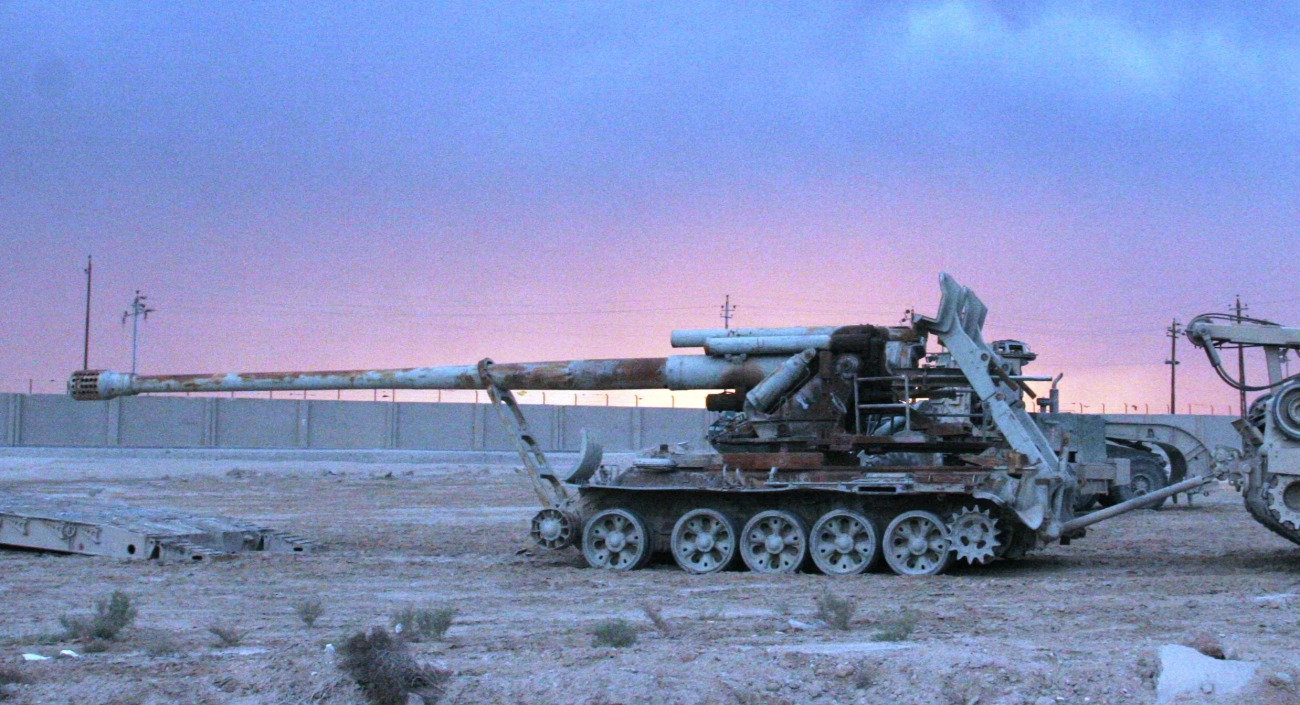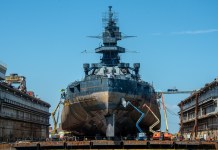Social media reports suggest that Russia has acquired 170mm self-propelled M-1989 Koksan guns from North Korea. These guns have been observed on trains in the city of Krasnoyarsk, central Russia, presumably heading towards the frontlines in Ukraine.
The Koksan is a vintage weapon first observed in the North Korean city of Koksan in 1978. Western intelligence gave it the Unofficial name based on the city where it was first observed. The official name of the North Korean gun is Chuch’ep’o or Juche Cannon.
The gun’s original M-1978 variant used a Chinese Type 59 tank chassis. The M-1989 variant features an improved chassis similar to the Soviet 2S7 Pion.
The gun’s unusual 177 mm caliber is likely best explained by its origin—it could have been developed either from similar caliber German WWII artillery or Russian coastal defense guns. (Russia has since switched exclusively to long-range missile systems for coastal defense.)
The Koksan fires standard shells to a range of 40 km and rocket-assisted projectiles (RAPs) to 60 km. It’s reported to have a low rate of fire—about one to two rounds every five minutes—likely due to manual loading and gun laying.
However, it’s possible that Russian and North Korean engineers have automated loading and laying on the guns that Russia is acquiring to the extent that gun barrel metallurgy now limits the rate of fire.
Why Does Russia Need the Koksan?
Why would Russian forces want to induct a slow-firing gun developed over 45 years ago?
Russia already has a large number of guns, howitzers, and mortars deployed along the battlefront in Ukraine.
- 2S19 Msta-S 152 mm howitzer with a range up to 24-29 km with standard ammunition, 40 km with RAP.
- 2S3 Akatsiya 152mm howitzer with a range of up to 17.4 km with standard shells and up to 24 km with RAP.
- 2S7 Pion (Malka) 203mm gun with a range of up to 37.5 km with standard shells, 47 km with RAP. (Notable for its very long range and large caliber, the Pion is designed for deep strikes against enemy artillery, command centers, and logistics.)
- 2S4 Tyulpan 240mm self-propelled mortar with a range of up to 9.65 km for conventional rounds and 18 km for rocket-assisted mines.
- Giatsint-B (2A36) 152mm gun-howitzer with range up to 27 km with standard shells, 40 km with RAP. (The gun features high-velocity fire for flat trajectory, which is good for counter-battery fire. The heavy weight of the gun makes it less mobile.)
- Koalitsiya-SV (Coalition-SV) 152 mm with a range of up to 40 km with standard shells, 70 – 80 km with advanced ammunition. (Highly automated, digital fire control, increased rate of fire, equipped with a modern chassis for high mobility, still in the process of full integration into service. It can fire over 10 rounds per minute, with reports suggesting up to 16 rounds per minute during optimal conditions due to an automated loading system.)
The above demonstrates that Russian self-propelled guns other than the Koalitsiya have a limited range, even when using rocket-propelled shells. In contrast, widely deployed Western-supplied artillery guns, like the French CAESAR, have significantly greater ranges with modern ammunition.
The Nexter Systems CAESAR, for example, has a range of 40 km with standard shells, 55 km with RAP.
Koalitsiya Limitation
Russia’s Koalitsiya is a newly developed gun. It was reportedly first deployed along the Ukrainian front in late 2023. It was developed specifically to outmatch many of its Western counterparts in terms of range, rate of fire, and automation.
However, as things stand, Russia relies more on MLRS systems than artillery guns for long-range fires.
For example, the BM-30 Smerch MLRS launches 300mm rockets with larger warheads to greater range. The Tornado-S, an upgrade of the BM-30 Smerch, has a range of between around 70-120 km.

MLRS vs Guns
While MLRS have longer ranges, they are not as versatile as modern artillery systems like howitzers. First and foremost, they are optimized for area bombardment but not counter-battery fire.
Artillery guns provide sustained fire and flexibility at mid-to-long ranges, often with more control over shorter distances than MLRS. They are more suited for counter-battery operations than MLRS.
Traditional artillery guns, such as howitzers, offer significant range flexibility, achieved by varying the propellant charge load of shells and the angle of fire.
Modern artillery, like the M777 howitzer, can often switch between direct and indirect fire modes and adjust range with precision-guided rounds.
Artillery guns typically cover ranges from a few kilometers up to around 30-40 km. Using RAPs, the range can go up to 70+ km.
This flexibility allows them to be used in a wider variety of situations, from direct support of infantry to long-range bombardment.
Limited Range Inflexibility of MLRS
MLRS systems are generally more constrained in their range adjustment compared to artillery guns. Since MLRS fires rockets rather than shells, altering range often means switching between different types of rockets or missiles rather than adjusting the charge or firing angle.
Each rocket type has a fixed minimum and maximum range, so MLRS systems usually can’t cover shorter ranges as flexibly as artillery guns.
One way of covering short ranges is to reposition the MLRS deeper within your territory. This is time-consuming and exposes the MLRS to counter-battery fire during repositioning.
Simplified Logistics with Guns
Relying on guns simplifies ammunition supply logistics, as shells are smaller than MLRS rockets. This can make artillery operations less logistically intensive and potentially more cost-effective for certain types of engagements, especially when precision is more important than spread.
The Rationale For The Koksan
The Koksan would give Russia the counter-battery capability it currently lacks due to its excessive dependence on MLRS for long-range artillery fire. It will augment Russia’s current counter-battery capability to meet the challenges that are likely to emerge in the immediate future.
In case the conflict escalates, as a result of the West green-lighting deep strikes into Russia using ATACMS, Russia’s augmented counter-battery capability will force Ukrainian forces to launch ATACMS from at least 50 km within Ukraine, thereby substantially reducing the number of targets in Russia that ATACMS could be used against.
In case the hot phase of the conflict ends with a ceasefire, a potent counter-battery capability would deter ceasefire violations by Ukrainian forces and prevent them from seizing a tactical advantage based on the long range of their Western-supplied guns.
- Vijainder K Thakur is a retired IAF Jaguar pilot, author, software architect, entrepreneur, and military analyst.
- VIEWS PERSONAL OF THE AUTHOR
- Follow the author @vkthakur




